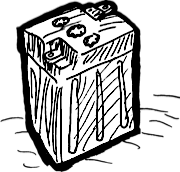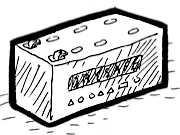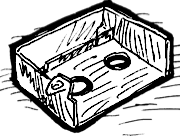Batteries





Battery - what is it?
A battery is a chemical storage device for electrical energy. Its special characteristic compared to other energy storage devices is the relatively constant voltage. Why do we say battery? A battery always consists of a "battery" of individual cells, hence the name (French batterie = several similar things in a row next to each other). The cells are electrically connected in series, therefore the voltages of the individual cells add up: e.g. 6 cells of approx. 2.1 V each result in a 12 V battery. The batteries in our Harleys can be recharged if they are drained. Actually, we should call them accumulators, but people ask for batteries for their FLH, Softail or Sportster, so why complicate things? Everybody knows what is meant.
What types of batteries are there?
Chemical storage means that chemical processes take place during charging and discharging. According to the substances and processes involved. We distinguish between lead-acid batteries or lithium-iron-phosphate batteries (LiFePo4 batteries) in motorcycle starter batteries. When we write lithum-ion batteries in the store, we mean the latter.
Lead-acid is the classical technology with lead plates and diluted sulfuric acid. It is based on an invention from the mid-19th century and has been improved and refined ever since. The cell voltage is ≈2.1 V. This is due to the chemical substances involved, lead and sulfuric acid. A lead-acid battery of today has little to do with the seething monsters of 100 years ago, but is, with good maintenance, a reliable partner through several motorcycle summers.
Lead-acid batteries are available as follows:
- "wet" batteries, where you have to fill in the sulfuric acid yourself and where you have to check the fluid level regularly.
- AGM batteries, where you can do nothing but check the charge level and recharge if necessary. The sulfuric acid is bound in a fleece between the lead plates.
- gel batteries. There is also only the state of charge to check. The sulfuric acid is bound (nothing can "slosh around"). The binding agent is silicic acid. Our AGM and gel batteries are sealed at the factory and must not be opened by the user. AGM batteries can be installed at an angle of up to 45°, gel batteries even horizontally (i.e. 90°).
LiFePo4 batteries have a much higher energy density than lead-acid batteries, i.e. same performance with much less space and weight. Or at comparable size, it they provide a much higher starting current than a comparable lead-acid battery. 90% of the charge can be used. In comparison: with lead-acid batteries only about 30%! That's why they are so big and heavy with comparable performance. Another advantage of LiFePo4 batteries is the much higher life expectancy compared to the lead-acid type. With good care, it can become as old as the motorcycle. The lead-acid battery is usually due for replacement after 4 to 5 years.
The cell voltage is 3.2 V. That is why only 4 cells are connected in series for 12 V applications. Unlike lead-acid batteries, which do not have any additional electronics, LiFePo4 batteries have internal electronics. This so-called balancer ensures that the individual cells are charged in a balanced manner.
What should I never do with any battery or accumulator? Battery No-Gos:
Short-circuiting! There are people who - in order to check whether a battery still has "juice" - hold a screwdriver to each pole and then cross the blades briefly. If there's a spark, there's still power! This is exactly what damages the battery. Short circuits allow such enormously high currents to flow that the inner workings of a battery can be seriously damaged. So please don´t do this. Tip: That's why you always disconnect the negative wire first when removing the battery. If the tool accidentally makes contact with the frame or another metal part, nothing will happen. The negative pole is connected to ground, and with ground to ground there can be no short circuit. For this reason, the negative wire is the last to be connected during installation.
Overcharging! All batteries must get regulated current and voltage when recharging. Your Harley has a regulator for this, if you want to charge your battery outside the motorcycle, you should use a suitable charger with regulation.
Deep discharge! Batteries that have been discharged to 10.5 V or less can be damaged if they are not immediately recharged. So take your finger off the starter button in good time and quickly connect the battery to the charger. Once a battery has been sitting around for a while, it takes special chargers to bring it back to life. And yet there is always the risk of residual damage.
Connect two or more in parallel! This only works with an external balancer, an electronic device that ensures that the batteries get equal charging current and voltage. Without this part, one will always be overcharged and one undercharged. Both is not good for the batteries and leads only to the fact that both are broken.

Have any questions?
Our service team will be glad to help out: Mondays - Thursdays 08:00-17:00 CET, Fridays 08:00-16:00 CET, Phone: +49 / 931 250 61 16, eMail: service@wwag.com